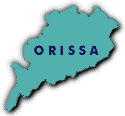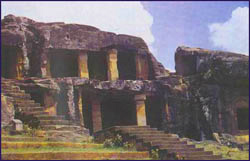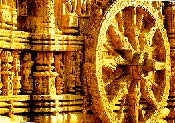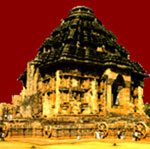| Destinations
| |||
 Although Orissa or Kalinga is mentioned in the epics, much of the history is obscure. A non-Aryan race is believed to have settled here in the dim past. Then came the Aryans from the north. Out of the gradual blending of the two, a new race and civilization came into being. At the dawn of history, Orissa formed part of the powerful kingdom of Kalinga that was practically coextensive with Oriyan speaking tracts and stretched from the mouth of the River Ganga to that of the Godavari. The kingdom was a challenge to the Mauryan Empire which was founded by Chandragupta Maurya. In 263 B.C. King Ashoka sent a powerful force to subdue Kalinga which offered stubborn resistance. The carnage that followed is depicted on some of the rock engraved edicts of Kalinga. He deeply regretted being the cause of this war, embraced Buddhism and turned to a life of compassion. In the first century B.C., under the rule of the third Chedi King, Kharavela, Jainism was restored as the faith of the people. Kharavela, the greatest king ever to rule Kalinga, launched a series of conquests, winning lands as far as Cape Comorin in the south, River Ganga in the north and Maharashtra in the west. During this time, Udaygiri and Khandagiri, 8 km to the west of Bhubaneshwar, became strong centres of the Jain faith. |
More About Orissa • An Overview • Geography • Culture
Places to Visit
Travelogues
Leisure |
||
 The fortunes of Kalinga's Chedi dynasty declined with the termination of brief but brilliant career of Kharavela. During the first two centuries of the Christian era it has many thriving ports from where merchants, priests and others sailed to Java, Sumatra, Bali and other places in South-East Asia. The colonies established by these people eventually grow into powerful kingdoms.
The fortunes of Kalinga's Chedi dynasty declined with the termination of brief but brilliant career of Kharavela. During the first two centuries of the Christian era it has many thriving ports from where merchants, priests and others sailed to Java, Sumatra, Bali and other places in South-East Asia. The colonies established by these people eventually grow into powerful kingdoms.
About the middle of the 4th century AD, Emperor Samadragupta of Magadha invaded Orissa. In 610 AD, Orissa came under the sway of King Sasanka. Following Sasanka's death in 625 AD, his rival Harsha Vardhana conquered Orissa where he tried to propagate the doctrine of Mahayana Buddhism.
Subsequently, there were frequent Muslim incursions into the State and, about 1361, Firoz Shah personally conducted an expedition into Orissa. Muslim incursions continued with increasing strength till at last, after a period of civil strife, Mukanda Deva, the last Hindu ruler of Orissa, was overthrown by Kala Pahar in 1568 AD. The Afghans held Orissa until 1592 AD, when Akbar's General Man Singh annexed it to the Mughal Empire. Orissa, ceded to the Marathas by Alivardi Khan in 1751, was conquered by the British in 1803. Two years later it was designated the District of Cuttack and placed in the charge of a Collector, Judge and Magistrate. In 1828 it was split up into the Regulation Districts of Cuttack, Balasore and Puri, and the non-Regulation Tributary States. Sambalpur was added to Orissa in 1905. Orissa was separated from Bihar and made a separate province in 1963 under the Government of India Act of 1935. After Independence in 1947, the rulers of 26 Orissa States surrendered their authority and jurisdiction to the Government of India. The merger of the Orissa states was completed in 1949. At present, Orissa has 30 districts covering an area of 1,55,707 sq km. Compiled by Pallavi Bhattacharya |
|||
Editor: Romola Butalia (c) India Travelogue. All rights reserved. |
|||

 About the middle of the 7th century AD the Somvamsi dynasty was established in Orissa. The first powerful ruler of the line, Mahabhavagupta Janamejaya (680 AD - 712 AD), extended his kingdom up to the modern Cuttack. He was succeeded by Mahasivagupta Yayanti I (712 AD - 744 AD ). In 795 AD Mahasivagupta Yayanti II came to the throne and united Kalinga, Kangoda, Utkala and Kosala and revived the imperial tradition of Orissa under Kharavela. He was a great patron of Brahmanism, Yayanti is said to have invited 10,000 learned Brahmins from Kannauj and settled them in Orissa. He is believed to have built a temple to Lord Jagannath at Puri. His son and successor Udyot Kesari Mahabahavagupta (840 AD - 880 AD) was a powerful ruler who espoused the cause of Saivism and built many temples.
About the middle of the 7th century AD the Somvamsi dynasty was established in Orissa. The first powerful ruler of the line, Mahabhavagupta Janamejaya (680 AD - 712 AD), extended his kingdom up to the modern Cuttack. He was succeeded by Mahasivagupta Yayanti I (712 AD - 744 AD ). In 795 AD Mahasivagupta Yayanti II came to the throne and united Kalinga, Kangoda, Utkala and Kosala and revived the imperial tradition of Orissa under Kharavela. He was a great patron of Brahmanism, Yayanti is said to have invited 10,000 learned Brahmins from Kannauj and settled them in Orissa. He is believed to have built a temple to Lord Jagannath at Puri. His son and successor Udyot Kesari Mahabahavagupta (840 AD - 880 AD) was a powerful ruler who espoused the cause of Saivism and built many temples.
 In the year 1038 AD, Vajrahasta III of the Eastern Ganga dynasty assumed the title of Trikalingadhipati ( Lord of Trikalinga ), and after thirty years of prosperous rule was succeeded by his son Rajarajadeva Deva I. The next ruler was Anantavarman Chodaganga, who is believed to have erected the tower and assembly hall at the temple of Puri. The Vaishnava kings of the Ganga dynasty were an illustrious line, the most notable among them being Anangabhima I, Rajaraja II, Anangabhima II, and Narashima Deva I. The last emperor is believed to have built the famous Sun Temple at Konarak.
In the year 1038 AD, Vajrahasta III of the Eastern Ganga dynasty assumed the title of Trikalingadhipati ( Lord of Trikalinga ), and after thirty years of prosperous rule was succeeded by his son Rajarajadeva Deva I. The next ruler was Anantavarman Chodaganga, who is believed to have erected the tower and assembly hall at the temple of Puri. The Vaishnava kings of the Ganga dynasty were an illustrious line, the most notable among them being Anangabhima I, Rajaraja II, Anangabhima II, and Narashima Deva I. The last emperor is believed to have built the famous Sun Temple at Konarak.